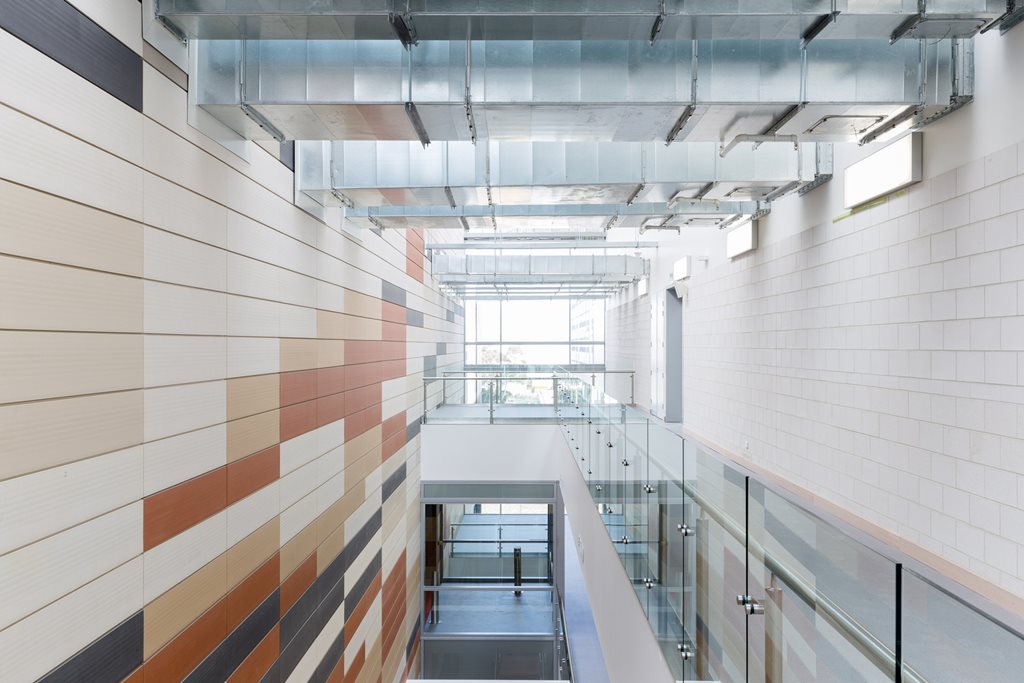The function of the National Archives Preservation Facility (NAPF) in Canberra is not just practical; it is also symbolic. Housing over 15 million records from our nation’s past, its role is not just to manage and preserve these important artefacts. It is also intended to act as a symbolic keeper of our collective memory.
When may + russell architects came on-board to design the facility, it was important to keep hold of several opposing sets of considerations. According to the architects, the predominant concept that played a role in determining the initial design was “to express the passage of time – both the past and the future”.
In order to represent these two tenses architecturally, may + russell split the design down the middle; a task made easier by the fact that the building was already split into two decisive functions.

The Records Management aspect of the building is where records are managed, processed and preserved for future use. It is where artefacts start their life and, as such, it “belongs to the now”. The design for this aspect of the building capitalised on straight lines, sharp angles and a metallic palette. The façade is “highly-finished” and “machine-like”, with straight lines and sharp angles used to suggest modern technology.
On the other hand, the Records Storage Building – where the nation’s historical documents are stored – symbolises the past. To replicate this idea of time passing, the architects made the façade to look like a feature of the weathered Australian landscape. It features “irregular patterns” and “weathered colours” to suggest the passage of time.


“The precast concrete form houses the archival function of the facility. [It] references our past and the Australian landscape by depicting a weathered and eroded mass, evoking a timeless granite outcrop catching a rising or setting sun,” says the architect in a design statement.
“In stark contrast, the space for archivists is representative of the present day and our future. The lightweight, metal-clad construction is a smooth, machine-like box with regular lines and modular openings.
“The central circulation spine [that] connects these two distinct spaces is called Archive Row. A light-filled atrium space to provide visual relief to transition between the starkly different environments, the 100-metre length is clad with clay panels of earthy tones, in a transient graphic depicting movement and the passage of time towards the future of digitised records.”
The tension between past and present wasn’t the only dichotomy may + russell needed to reconcile in their design for NAPF. The site itself runs adjacent to a key commuter road, which links Canberra city to Gungahlin. As a major transport corridor and site for Canberra’s future light rail system, most of the people that pass the facility during the day will be doing so as part of their daily commute. In other words, either at dawn or at dusk.
The envelope of NAPF is primarily composed of pre-cast concrete panels, articulated with the specific intention of accentuating the sun’s angles. The form and palette of the building appears to change throughout the day – from dawn to dusk – as different angles of light in turn throw different patterns of shadow.

“The north and south edges of these panels are respectively pronounced with dusk- and dawn-coloured fins, which playfully engage commuters to contemplate the passage of time.”
Seemingly all about dual meaning, may + russell decided on pre-cast concrete panels for its additional efficiency as a thermal insulator. The archival function of NAPF necessitated that the façade design be devoid of windows, and added pressure for the architects to ensure consistently optimal levels of heat and light to the interior.
“The box form and unitised structural grid provides the most efficient floorplate for mobile storage compactus unit, which drove the planning of the egress stairs externally, and hence celebrated with the colours of dawn and dusk,” says the architect.
“Although the future of archives forges into the digital age, the NAPF is a unique facility [that] tells the story of the nation – both the past and the future.”

